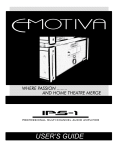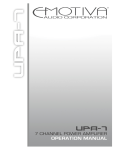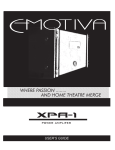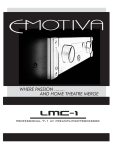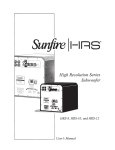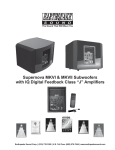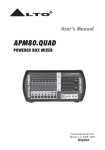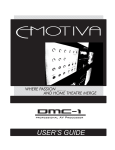Download Emotiva RSP-1 User`s guide
Transcript
USER’S GUIDE Table of Contents Safety Precautions 4 NEC (National Electrical Code) Standards 6 A Note for the Cable Television (CATV) Installer Antenna Grounding Outside the House 6 6 Thank You for your RPA-1 Purchase 7 Unpacking the RPA-1 8 Inventory Recording the Serial Number 8 8 RPA-1 Front Panel Layout 9 Emotiva RPA-1 Reference Power Amplifier 9 Audiophile 2 Channel Amplifier Features 9 RPA-1 Rear Panel Layout 10 Installation and Connections 11 AC Power Considerations Physical Placement Input Connection Considerations Output Connection Considerations Connection Tips for Superior Sound 11 11 12 12 12 Connection Diagrams 13 Connecting a Preamp 13 Connection of a Preamp Level Device using XLR Inputs Connection of a Preamp Level Device using RCA Inputs 13 13 Connecting Speakers 14 Connection of a Stereo Speakers Biamped Connections (Low Pass and High Pass) 12V Trigger Connections Speaker Output Connections 14 15 16 16 Series and Parallel Speaker Connections 17 Series Parallel Technical Note about Multiple Speaker Connections 17 17 18 Speaker Placement Tips 19 Tips Before Beginning 19 The Front Speakers Subwoofer Location (for 2.1 Systems) 20 20 Troubleshooting Guide No Sound (from one or more speakers connected to the RPA-1) The amplifier shuts down often or the line circuit breaker trips often Poor Bass Performance From Full Range Speakers connected to the RPA-1 Turn-on and turn-off thumps “Hum” Noises in the Speakers Other Probable Causes of Noise RED light on the front panel blinks from blue to red RED light on the front panel is illuminated solid red Problems with the whole Audio System 22 22 22 22 23 23 24 24 24 24 RPA-1 Technical Specifications 25 Trademark Disclosure 26 Emotiva Disclosure Limited Warranty Service Assistance for the RPA-1 26 27 27 Safety Precautions Read this User’s Guide thoroughly before attempting to install and configure the Emotiva RPA-1 Amplifier. All the safety and operation instructions should be read before any operation of the component(s) begin. After successful installation and configuration of the Emotiva RPA-1 Reference Power Amplifier, be sure to retain this manual in a safe place for any future reference needs. All warnings on the Emotiva RPA-1 Reference Power Amplifier and in these operating instructions should be followed. Safety is a key component to a long lasting and trouble free installation. The vast majority of the subsequent safety precautions involve simple common sense. If you are not comfortable with the installation of audio/video entertainment equipment, it will be to your benefit to seek the services of a qualified installation professional. • The Emotiva RPA-1 Amplifier should NEVER be used near water such as a bathtub, washbowl, kitchen sink, laundry tub, in a wet basement, or near a swimming pool, etc. • The Emotiva RPA-1 Amplifier should be situated so that its location or installation position does not interfere with proper ventilation. • The Emotiva RPA-1 Amplifier should not be situated on a bed, sofa, rug, or similar surface that may block any ventilation openings; or placed in a built-in installation such as a bookcase, cabinet, or closed equipment rack that may impede the flow of air through ventilation openings. If installed in a closed equipment rack for custom installations, be sure to add forced air ventilation so that it has adequate air circulation. • The Emotiva RPA-1 Amplifier should be situated away from heat sources such as radiators, or any other devices which produce heat. • The Emotiva RPA-1 Amplifier should be connected to a power supply only of the type described in this User’s Guide and what is labeled on the RPA-1 component. Power supply cords should be routed so that they are not in high foot traffic areas or pinched by items placed upon or against them, paying particular attention to cords at the wall plugs, convenience receptacles, and the point where they connect into the RPA-1 Amplifier. The power cord of the RPA-1 Amplifier should be unplugged from the outlet when unused for a long period of time. When it’s time for cleaning the Emotiva RPA-1 Amplifier, it should be cleaned only as recommended in this User’s Guide. Never spray liquids directly into the component’s vent openings. Care should be taken so that small objects do not fall into the inside of the RPA-1 Amplifier. The following situations require your Emotiva RPA-1 Amplifier is serviced only by qualified service personnel: 1. The power-supply cord or the plug has been damaged; or 2. Objects have fallen, or liquid has spilled into the component; or 3. The RPA-1 has been exposed to rain; or 4. The RPA-1 does not appear to operate normally or exhibits a marked change in performance; or 5. The RPA-1 has been dropped, or its enclosure or chassis is damaged. The user should not attempt to service the RPA-1 Amplifier beyond the means described in this User’s Guide. All other servicing should be referred to qualified service personnel. Page 4 To prevent electric shock, do not use this polarized plug with an extension cord, receptacle or other outlet unless the blades can be fully inserted to prevent blade exposure. Pour preevenir les chocs electriques ne pas utiliser cette fiche polarises avec un prolongateur, un prise de courant ou une autre sortie de courant, sauf si les lames peuvent titre inserees a fond sans laisser aucune parIIIe a decouvert. Grounding or Polarization — Precautions should be taken so that the grounding or polarization means of the component is not defeated. This apparatus does not exceed the Class A/Class B (whichever is applicable) limits for radio noise emissions from digital apparatus as set out in the radio interference regulations of the Canadian Department of Communications. ATTENTION — Le present appareil numerique n’emet pas de bruits radioelectriques depassant las limites applicables aux appareils numeriques de class A/de class B (selon le cas) prescrites dans le reglement sur le brouillage radioelectrique edicts par les ministere des communications du Canada. For questions regarding service, please contact: Emotiva 106 Mission Court, Suite 101 Franklin, TN 37067 Tel - (615) 771-1224 Fax - (615) 771-1128 (877) EMO-TECH www.emotiva.com WARNING – TO REDUCE THE RISK OF FIRE OR ELECTRIC SHOCK, DO NOT EXPOSE THIS APPLIANCE TO RAIN OR MOISTURE. CAUTION: TO PREVENT ELECTRIC SHOCK, MATCH WIDE BLADE OF PLUG TO WIDE SLOT, FULLY INSERT. ATTENTION: POUR EVITER LES CHOCS ELECTRIQUES, INTRODUIRE LA LAME LA PLUS LARGE DE LA FICHE DANS LA BORNE CORRESPONDANTE DE LA PRISE ET POUSSER JUSQU’AU FOND. Page 5 NEC (National Electrical Code) Standards A Note for the Cable Television (CATV) Installer This reminder is to call the CATV system installer’s attention to Article 820-40 of the NEC that provides guidelines for proper grounding and in particular, specifies that the cable ground shall be connected to the grounding system of the building as close to the point of cable entry as practical. Antenna Grounding Outside the House If an outside antenna is connected to the receiver, be sure the antenna system is grounded so as to provide some protection against voltage surges and built-up static charges. Article 810 of the National Electrical Code, ANSI/NFPA 70, provides information with regard to proper grounding of the lead-in wire to an antenna-discharge unit, connection to grounding electrodes, and requirements for the grounding electrode. See diagram below. Always observe proper antenna or satellite dish grounding techniques. When lightning strikes there is always the possibility that your antenna or dish (mounted high on the roof) can become a conduit for lightning and electrically damage any equipment to which it’s connected. Additionally, proper grounding offers safety to the people using the audio/video system in the event of an electrical problem. Page 6 Thank You for your RPA-1 Purchase Dear Home Entertainment Enthusiast, Thank you for purchasing the Emotiva RPA-1 Reference Power Amplifier. We sincerely believe that it offers you outstanding performance and value. Emotiva products are engineered and produced with the highest quality materials and incorporate the latest technology. We think you will find the Emotiva RPA-1 meets or exceeds your expectations. The Emotiva RPA-1 is unlike any two channel home audio amplifier on the market. It has been designed with the user in mind. By employing technology that makes sense yet with a clear focus on the priority of superb sound reproduction, the Emotiva RPA-1 allows you to spend more time enjoying your music. What’s more, the Emotiva RPA-1 does it all with exceptionally refined cosmetics and a build quality that will satisfy even the most discriminating tastes. The Emotiva RPA-1 features an array of leading edge technologies and all the features necessary to perform the functions expected of a high end stereo amplifier. At Emotiva, we remember that creating home entertainment products means that they should be easy to use while delivering unparalleled performance. Page 7 Unpacking the RPA-1 The Emotiva RPA-1 Reference Power Amplifier should reach you in flawless condition. If you notice any shipping damage or other issues upon unpacking the unit, please contact your Emotiva Retailer immediately. Inventory Gently lift out the unit and remove all the packing material and accessories. It is important to save all the packing materials and the box in case your Emotiva RPA-1 ever needs to be moved or shipped back to the factory for service. Make sure that you keep your sales receipt. It is the only way for Emotiva to establish the duration of your Limited Warranty and it may come in useful for insurance purposes. Please take a moment to fill out and mail the Emotiva Customer Response card. Recording the Serial Number Please read the serial number located on the rear panel and record it below. Also record the place where you purchased this product and the date of purchase. Model Number Serial Number Place of Purchase Date of Purchase Page 8 RPA-1 Emotiva RPA-1 Reference Power Amplifier Audiophile 2 Channel Amplifier Features • Dual mono block design • Extremely low residual noise floor • Dual high current toroidal power transformers • Enhanced Emotiva EPM power module topology • 200 watts RMS per channel into eight ohms • 300 watts RMS per channel into four ohms • 1Hz – 80kHz bandwidth • THD+N - .015% • Convection cooling • Analog VU meters • 12VDC trigger input • Balanced XLR and unbalanced inputs • Tiffany style RCA inputs • High-quality, high current binding posts • Panel dimmer • Milled multi-element floating wing faceplate with indirect cobalt blue illumination. • IEC power inlet, 120/230 VAC user configurable RPA-1 Front Panel Layout 1 2 Front Panel Power Switch This switch provides the ON/OFF control of the RPA-1 from the front panel. When the unit is off and in standby mode, the switch illuminates yellow. Automatic switching is accomplished with the two terminal trigger input on the back panel using a 5-12VDC control signal. Panel Dim Switch This switch dims the blue front panel illumination. Press to dim and scroll through the various brightness levels until you find a level you like. 3 2 1 3 Front Panel Display The front panel display contains VU meters to indicate dynamic output levels as well as an informative LED status light in the center to indicate the condition of the RPA-1. BLUE LED = FLASHING RED LED = SOLID RED LED = Normal Operation, Signal Levels are Normal Signal Levels are Peaking Amplifier Fault (Short, Thermal, or DC) See “Troubleshooting” section for details on the fault conditions and how to diagnose/fix them. Page 9 RPA-1 Rear Panel Layout 8 1 2 3 9 4 7 5 6 1 RCA Audio Inputs These RCA inputs provide the signal information for the left and right channels of the RPA-1. Simply connect them to the appropriate output of the preamplifier or other preamp level audio device. 7 2 Master Power Switch This rocker switch provides the master power for the RPA-1. After it is in the ON position, the amplifier can be turned on manually from the front panel switch or automatically with the trigger input via 2 wire connection. XLR Audio Inputs These XLR inputs also provide the signal information for the left and right channels of the RPA-1 and are the preferred method of input signal connection whenever possible. Simply connect them to the appropriate output of the preamplifier or other preamp level audio device that has XLR outputs. 8 Remote Turn On Connector This 2 wire connection accepts a 5-12 volt input for remote activation of the RPA-1. If you have the companion Emotiva RSP-1 or are building your own cable for a device with a 1/8” jack, be sure to identify the polarity of the jack pins. On the Emotiva RSP-1, center is positive and outer shield is negative. 3 Speaker Outputs (5 way Binding Posts) These are the speaker outputs. The 5 way binding posts accept stripped speaker wire, banana plugs (single or dual), or spade connectors. Be sure to observe correct polarity when connecting speakers and be sure that the wires do not touch between positive and negative terminals. 9 Turn On Selector Switch This switch allows you to select how the amplifier will turn on and off. 4 5 6 Serial Number Record this on page 8 of this user’s guide for reference in the event you need service or if the component is ever stolen. On Board Fuse This fuse is a T15AL for 110 volt applications and a T8AL for 220 volt applications. Please replace only with the correct type of fuse. Power Receptacle Standard IEC power receptacle. It is advised that this amplifier have a direct connection to a wall outlet. Do not plug into a “power strip”. Line voltage switch above selects the appropriate line voltage for your country. Page 10 In the ON (Right) position, the switch on the front of the amplifier is the method you will use to power up and power down the amplifier. Please note that in this configuration, you must manually power up and power down the amplifier each time you use it or it will have unnecessary standby current draw. In the SIGNAL (Middle) position, the amplifier automatically turns on whenever it senses an audio signal on either of the two amplifier channels. The circuit stays active for about 30 minutes after the absence of any audio signal to account for quiet passages of music or dialogue. In the TRIGGER (Left) position, the amplifier’s ON and OFF functions are controlled by a trigger from a source or preamplifier device. The trigger accepts 12 VDC and will turn the amplifier on whenever a trigger is present. When there is no trigger, the amplifier goes into standby mode. This is the preferred method for activating the RPA-1. Installation and Connections AC Power Considerations Ensure that the unit is plugged into an outlet capable of supplying the correct voltage and current specified for your model. Remember to account for the electrical power that other components will require if they share a common wall socket or electrical circuit. The majority of household electrical sockets in places other than the kitchen and garage are 15 amperes maximum. Most CD players and other source components are fairly low current items. When both channels are driven, the Emotiva RPA-1 requires a minimum of 10 amperes @ 120 volts or 5 amperes @ 230 volts when driven into 8 ohms. It should be sufficient to allow the other devices such as preamplifiers and A/V source units to share a wall socket, but power amplifiers such as the RPA-1 and a video display (big screen TV or video projector) should be provided a SEPARATE electrical connection on a SEPARATE circuit. As the RPA-1 has a minimum requirement that can consume nearly one entire circuit, please use a second (separate) electrical connection for other devices. DO NOT plug the RPA-1 into a power strip or extension cord unless the device is specifically designed and rated for high current use. Refer to your preamplifier, A/V source component(s), and video display owner’s manuals to learn the power requirements so you can safely plan your electrical power requirements for your home entertainment system. Upon powering up the RPA-1 with the front panel switch or via trigger input (switch on the rear panel must be set to “ON”), you will notice the front panel center LED status light illuminates blue. This indicates the amplifier is on, functioning normally, and ready for operation. If you experience a red LED light while the amplifier is on during high output operation, this indicates a “peak” condition (also called “clipping”). If the status LED in the center is solid red and the amplifier has shut down, this indicates a fault condition. For more information on diagnosing the fault, please refer to the troubleshooting section of this manual. Physical Placement Place the RPA-1 on a flat, level surface. Please distribute the weight equally on the four feet. Please give this unit adequate ventilation for proper cooling when placing. If this unit is placed in a cabinet, please make sure that the cabinet’s rear is open to fresh air and there are at least 6 inches of free air space above the amplifier and 1 inch on each side. If the amplifier is located on a carpeted surface, place a board under the amplifier’s feet. If the cabinet’s design will not accommodate an open rear, install two small brushless DC fans (such as those used in computer cases) to provide continuous air flow into and out of the cabinet. Do NOT block the ventilation holes on the RPA-1. The RPA-1 is equipped with massive toroidal power transformers. These transformers generate a magnetic field that could induce a hum in a turntable (particularly a turntable equipped with a moving coil cartridge). Do NOT place a turntable directly above or directly adjacent to the RPA-1. Before placing the RPA-1 on a shelf, verify that the weight bearing capacity of the shelf is 45 lbs or greater. The amplifier is heavy and should be placed toward the bottom of an audio rack to minimize the rack being unnecessarily top heavy. Page 11 Input Connection Considerations Whenever possible, keep preamp level audio cables away from electrical power cords by at least a few inches. It’s more important with amplifiers as the AC power cords are carrying much more current than other source and preamplifier components, which means there is a larger degree of noise or “hum” potential with the amplifier power cord in close proximity. Output Connection Considerations The output connectors provided on each channel of the RPA-1 are standard “binding post” speaker connectors with industry standard spacing. These are sometimes called 5-way binding posts because of the many ways in which the speaker wire can connect into the posts. The posts can accept bare wire, spade terminals, and dual or single banana connectors. Spade connections or banana plugs ensure a simple, solid fit in the terminal whereas bare wire may be awkward when the terminal is screwed down to compress the wire into place. Keep in mind that if you use “dual banana” plugs and “stack” them, you will be creating a parallel connection. For more details on series and parallel connections, see page 16. It is important to observe polarity so that the speaker wire connects to the red and black terminals on the amplifier and the corresponding terminals at the speaker. Also make sure that the positive speaker wires do not touch the negative speaker wires, or any chassis metal. This will cause a short circuit and activate the protection circuitry. Connection Tips for Superior Sound Before setting up your new system, please consider the following: • Always make sure the RPA-1 is turned off before making or changing ANY connections. • Whenever possible, route the power cords away from the signal cables or speaker wires to prevent any hum or interference heard in the speakers. • Whenever possible, use the XLR connections. These exhibit better noise rejection qualities. • Many RCA type patch cords can be a very tight fit and there is usually a preferred method of getting them off. Some have to be removed with a twisting action. Be gentle or you may damage the jacks of your RPA-1, the cables themselves, or other components. • Many audiophile signal cables are intended to be hooked up in one direction. If this is the case the cables will be marked with arrows the direction of signal flow. • It is usual for the right channel RCA patch cord plugs to be red and the left channel connections to be white, grey, or black (depending on the cable brand). RCA connectors that are gold will be designated with a colored band to designate the channel. Page 12 Connection Diagrams Connecting a Preamp Connection of a Preamp Level Device using XLR Inputs This diagram shows the RPA-1 amplifier connected to a preamplifier with XLR outputs. This is the preferred method of connection where possible. Connection of a Preamp Level Device using RCA Inputs This diagram shows the RPA-1 amplifier connected to a preamplifier with RCA outputs. If the preamplifier does not have XLR outputs, this becomes the default connection. Page 13 Connecting Speakers Connection of a Stereo Speakers This diagram shows a traditional single connection to two loudspeakers, one left channel and one right channel. Internally the speakers have passive networks so there is just a single speaker connection. In this case, if there were multiple input terminals and you intend to drive each speaker with a single amplifier channel, you must make sure the shorting bars are in place on the speaker joining each positive to positive and negative to negative. Page 14 Biamped Connections (Low Pass and High Pass) This connection shows two RPA-1 amplifiers used in a bi-amp mode. One of the amplifiers is connected to the low frequency drivers and has a low pass filter employed by the preamplifier. The other amplifier has a high pass filter employed and is connected to the mid and high frequency drivers. Please note that if using this configuration with the Emotiva RSP-1 preamplifier, the SUB out is a L+R mono output and may not be suitable for your stereo speaker situation. If so, you will have to split this signal with a “Y” adapter cable. This setup is mostly ideal when smaller component speakers will be used with a separately placed subwoofer. Page 15 12V Trigger Connections The 12 VDC trigger connection shown can be used to turn the amplifier on when the preamplifier turns on. This trigger will actually trigger with any switched DC Voltage from 5-12 VDC, however the majority of audio components use a standard 12 VDC trigger connection for this function. This is the preferred connection as it has the greatest degree of reliability. Never switch anything that plugs directly into the wall with this trigger connection. This action will damage the unit and VOID THE WARRANTY. Speaker Output Connections The insulated speaker output terminals for each amplifier channel are located right next to the RCA and XLR inputs. The top post of each binding post pair is the positive output, and connects to the positive (red) post of your speaker. The bottom post of each pair is the negative, and connects to the negative (black) post of your speaker. Regardless of the speaker configuration used for the RPA-1 amplifier channels, proper connection of each speaker is essential. The 5-way binding posts can accept bare wire, spade terminals, and dual or single banana connectors. Spade connections or banana plugs ensure a simple, solid fit in the terminal whereas bare wire may be awkward when the terminal is screwed down to compress the wire into place. Keep in mind that if you use “dual banana” plugs and “stack” them, you will be creating a parallel connection and this amplifier is not rated to play below 4 Ohms per channel. Page 16 Series and Parallel Speaker Connections Whenever connecting more than one speaker per channel to an amplifier (regardless of the brand), you must consider the way in which the amplifier will be impacted by adding the additional speaker(s). Additionally, speakers with dual voice coils also apply to this consideration. Two voice coils in a single speaker also cause different reactions from an amplifier depending on the way in which they connect to the amplifier. The connection of more than one speaker per channel will tend to degrade the speaker’s frequency response and may make the amplifier run hot. For the best sonic results, use one speaker per amplifier channel. If you must connect more than one speaker per channel, there are two methods in which to do so: Series or Parallel. Series A series connection is established when voice coils are connected in a string – end to end – so there’s only one way for audio signals to flow “in” and only one way for audio signals to flow “out”. For example, if you were to series-connect two speakers to the front right channel of the amplifier: • The positive output terminal of the right channel connects to the positive input post of the first speaker. • The negative input post of the first speaker connects to the positive input post of the second speaker. • The negative input post of the second speaker connects to the negative output terminal of the right channel. An example of a SERIES connection between two speakers The total impedance of speakers in series is found by adding their impedances together. For example, two four ohm speakers in series is an eight ohm load. Series connections are easier on the amplifier than parallel connections as the total impedance is higher than driving a single speaker. Parallel A parallel circuit is established when voice coils are connected in a way that there are multiple paths for audio signals to flow “in” and multiple paths for audio signals to flow “out”. When speakers are connected in parallel, the total resistance at the amplifier is proportionally divided based on the value of each individual voice coil resistance. The term “divided” simply means all of the values together in parallel are a SMALLER value than each all by itself. For example, if you were to parallel connect two speakers to the front right channel of the amplifier: • The positive output terminal of the right channel connects to the positive input post of the first speaker and to the positive post of the second speaker. • The negative output terminal of the right channel connects to the negative input post of the first speaker and to the negative post of the second speaker. An example of a PARALLEL connection between two speakers Page 17 The total impedance of equal speakers in parallel is found by dividing the impedance of one speaker by the number of speakers. For example, two eight ohm speakers in parallel is a four ohm load (eight ohms divided by two), four eight ohm speakers in parallel is a two ohm load (eight ohms divided by four). Two ohm single channel loads are NOT RECOMMENDED for the RPA-1! Running the RPA-1 below recommended impedance level can cause excessive heat and will eventually drive the amplifier into protection (blinking red LED on the front of the unit). Parallel connections are harder on the amplifier than series connections, as the total impedance is lower compared to driving a single speaker, and the amplifier must produce more current to drive them. Ideally, the total average impedance should be no less than 4 ohms per channel. You must make sure that the lower impedance does not cause the amplifier to overheat, shut down, blow the line fuse, or trip your circuit breaker. If this happens, you should reduce the number of speakers wired in parallel, rewire them in series, or use more than one power amplifier. Technical Note about Multiple Speaker Connections Although there are two possible connection types discussed in this manual, it is imperative that with either connection type that you use loudspeakers of the same type and nominal impedance for these connections. In doing so, you have the most predictable outcome for your installation. When speakers of different nominal impedances and/or different bandwidths are used, there are many other acoustic problems that come into play in addition to complex impedance at the amplifier’s speaker output terminals. If you must use multiple speakers on any individual amplifier channel, please use speakers as close to identical as possible. Page 18 Speaker Placement Tips Tips Before Beginning Read this section thoroughly. There are a number of ways in which it may seem aesthetically pleasing to place speakers in a room that will ultimately result in a sound quality compromise. The placement of speakers is equally as important as the room itself. While there may be very little you can do about the room where your home theater is installed, you can choose placement of speakers within that room to maximize the sound quality of the system. Ultimately, this will give a much better result when you are enjoying your home theater and your new Emotiva RSP-1. Overall, the best placement for front speakers is where the sound is directed at ear level. This means that the speakers themselves can be in positions lower (like small floor standing speakers) or higher (like in-wall or in-ceiling speakers) as long as the sound is “pointed” toward the listeners and preferably around ear level. Ideally you will place the speakers so they create an imaginary triangle with the listening position. This is known as the “Stereo Triangle” among audiophiles. A little toe-in of the front speakers sometimes helps the perceived distance between the speakers as more intimate and reinforces a phantom center image. If you are doing a “2.1” system, a subwoofer can also be a little challenging to install depending on the room. In multiple subwoofer installations, the positioning of the woofers to the listener as well as to each other is critical because there can be problems with cancellation if optimum placement is not observed. Page 19 The Front Speakers You should closely follow the placement recommendations of your speaker manufacturer, with the addition of the following points: • The left and right front speakers should be positioned so that your TV is exactly centered between them. This will help create a stable phantom center image • For the best overall imaging, the left speaker should be set exactly the same distance and angle away from your listening position as the right speaker. It is recommended that you use a tape measure to set them up to be the same distance away, within about half an inch tolerance. Place LEFT and RIGHT main speakers at equal distances from the listening position as if to create an If you have a smaller TV, the speakers should be no more than two imaginary triangle between the listening position and feet away from the sides of the TV. If possible, have the center, left the speakers. and right speakers at the same height (within two feet). This will help give a smooth transition when sound effects move from speaker to speaker. Subwoofer Location (for 2.1 Systems) A subwoofer typically sounds best in a corner with at least 5 feet of wall to either side. Due to the short wavelengths of highfrequency sounds, they don’t interact strongly with the size and shape of a room. Lower frequencies long wavelengths that can cause “Standing wave” problems. Placing the subwoofer in a corner usually creates the best possible situation for the sound to interact with the room, allowing even distribution of the bass frequencies. Often the corner that offers nearby placement to the front speakers may yield the best results, but you should try several locations before settling on just one. The best location for a single subwoofer can be found by playing a couple of different low frequency test tones (or some music with heavy sustained bass passages) and proceeding with the following easy 1-2-3 process: Standing waves depicted in a room. “Peaks” are good, “Dips” are bad. 1. Place the subwoofer right on the seat of your couch or listening chair. 2. You can then either run the calibration (noise) signal through it, or simply plug the analog outputs of a CD player directly into your subwoofer’s low-level inputs. Turn down the subwoofer’s volume level before turning on the CD, then play the test tones or some music with heavy sustained bass passages. 3. Walk around the room, standing in all the positions where you might be able to place the subwoofer. Again, this is usually near the corners of the room. Try locations fairly close to the front speakers. Page 20 1 2 Place the subwoofer in the listening position 3 Play a test tone or low bass music Walk around the room and see where the bass has the best performance. That’s where your subwoofer belongs! Notice where in the room the bass output from the subwoofer sounds the loudest. Shut things down and install the subwoofer there. This is the best position for the subwoofer. The bass will sound the best when you are sitting in your normal listening position. If your subwoofer seems to sound best when it is near the front speakers (often the case), keep in mind that most television sets may not react well to the subwoofer if it is not built specifically for use in a home theater application. While most front Left/Center/Right speakers do have shielding when intended for use in a home theater application, subwoofers are not always magnetically shielded and may damage the television if placed too close. If you want to check if this will be a problem, select an unused video input on the television to bring up a single color screen. If you see any color distortion anywhere on the screen, an unshielded speaker is too close to the screen and should be moved away from the television until the color distortion disappears. Note - most powered home subwoofers feature a phase control with a range between 0-180 degrees. This is present so that in situations where the optimum location is not particularly desirable, you can locate the subwoofer elsewhere nearby and make a slight adjustment to the phase so that is sound arrives to the listener at the same time as the other speakers. Ideally, sound arriving at the same time is what allows the subwoofer to create the illusion of the main speakers making the bass. This is what enhances the listening experience. Page 21 Troubleshooting Guide The Emotiva RPA-1 is expertly designed and built to provide years of trouble-free performance. Most problems that occur can usually be solved by checking your setup or making sure that the audio and video components connected to the RPA-1 are on and fully operational. The following information will help you deal with common setup problems you may experience during normal use of your unit. If problems persist, contact your Emotiva Dealer for help. No Sound (from one or more speakers connected to the RPA-1) • Speaker cables may have come undone. Turn off your system and check the cables, and tighten the amplifier and speaker binding posts. • Damaged audio cable. • The preamplifier volume level is low for the channels concerned. Recheck the preamplifier calibration procedure. • A preamplifier Mute switch may be on, or an external processor loop or a tape monitor loop is engaged. • If the unit is not on, the ON/OFF switch on the RPA-1 might be in the off position. • The internal fuse on the unit may have blown. If so, replace only with rated fuse size and type. The amplifier shuts down often or the line circuit breaker trips often • Check that the positive and negative speaker wires are not shorted together. • Make sure that no speakers are shorted internally. If you have an ohm-meter, disconnect the speaker wires and measure the resistance between the speaker’s positive and negative terminals. If the reading is less than 3.2 ohms on either channel, the speakers may have an internal short or you have connected several using a parallel configuration that yields too low an impedance. Measure all speakers and check their impedance specifications. If necessary, review the “Series and Parallel Connections” section of this manual. • If you have connected speakers in parallel, the overall impedance may be too low. It is recommended that you rearrange the speakers in series to increase the overall impedance, thus taking some of the load off the amplifier. • Make sure that the amplifier has good ventilation and is not overheating. Allow good airflow underneath wherever possible. If the amplifier is in a closed rack, open up the rear panel or use a quiet fan for improved ventilation. Poor Bass Performance From Full Range Speakers connected to the RPA-1 • Make sure that your preamp does not have the bass (tone control) level turned down. • If the preamplifier has a HPF, make sure that it has been correctly set. If you are not using a subwoofer, set the high pass filter to “BYPASS” (if available) or just use full range outputs into RPA-1 so that there is no path through a crossover and the speakers will play full range. • Check that the speaker wires have been connected correctly: Make sure that the positive of each speaker connects to a positive output of the amplifier, and the negative of each speaker connects to a negative output. If one speaker is wired incorrectly, than it will be “out of phase” with the others, resulting in poor bass performance. DOUBLE CHECK ALL THE SPEAKER CONNECTIONS!! Page 22 Turn-on and turn-off thumps • Plug the amplifier into an un-switched AC outlet, and use the 2 wire Trigger Input connection with a trigger between 5-12VDC from the source unit or preamplifier (such as the Emotiva RSP-1 Preamplifier). This should allow the amplifier to turn on and off silently. • If your powered subwoofer is the cause of the “thump” sound (not the other speakers connected to RPA-1), plug it into a different 110VAC outlet than the RPA-1 amplifier so there is no power surge conflict. • Install a line conditioning device. Contact Emotiva or a professional installation specialist for details. “Hum” Noises in the Speakers This problem is more than likely caused by a “ground loop” in your system, rather than a fault in the RPA-1. Follow these steps to isolate the main cause of the hum, there may even be more than one. Remember to turn off all components in your system, including the RPA-1, before disconnecting or connecting any cables. • Remember to turn off all components in your system, including the amplifier, before disconnecting or connecting any cables during troubleshooting. • Try to have all of your equipment on the same electrical outlet or circuit. Group all the low power components (preamp, CD player, DVD etc.) on a single outlet or power strip. This is provided that the overall current draw from your equipment does not exceed the rating of the outlet or breaker. • Disconnect all cables which come from outside the room, and check if the hum goes away. This includes such connections as cable TV, satellite TV, or roof top antennas. Make sure that they are disconnected where they first enter the room, so they are making no connection to the preamplifier or the TV, or any other component. If the hum is caused by the cable TV line, then you will need a “ground loop isolator.” This is an inexpensive device fitted in line with the coaxial cable feed. Contact your cable company or your Emotiva Dealer for assistance. • Disconnect all connections from the preamplifier to your TV, VCR or DVD. • As a test, disconnect any other component which has a grounded power cord. NOTE: Never remove the ground pin from any power cords (if present). This is very dangerous. • If the hum persists, disconnect all the source components one at a time from the back of the preamplifier, until you identify the problem. • Try moving the speaker cables away from any power cords. Try just one speaker, connecting it to each amplifier channel and see if one channel is bad. • Check that the interconnect cables to the amplifier do not have any broken connections. The best way to do this is to substitute a known good connection for the suspect connection. If you reverse the cables and the problem goes away, the cable may be damaged or broken. This is possible even if you can’t physically see the break as the strain for pulling on audio cables can sometimes break the wire internally. Ground loop isolators are available for audio lines and video devices. If you need assistance, contact your Emotiva Dealer. Although this is not always an ideal solution, the grounding differences between certain home entertainment components sometimes require ground loop isolators. This is the exception rather than the rule. Page 23 Other Probable Causes of Noise Speaker noise may also be caused by interference or noise on your AC line. Make sure there are no large appliances sharing the line, or halogen lamps or light-dimming Triac devices. • Try connecting your system to another AC socket on a separate line. • If the hum is heard from within the RPA-1 and not through the speakers, this may also be caused by interference on the AC or DC lines. The power transformers may turn this interference into an audible noise. Internal hum can be made worse by a shelf or cabinet resonating, so try moving the RPA-1 to another shelf. • Try moving your components further away from the TV, especially if you ever notice the screen has changed color in the area closest to the component. • If you have very high efficiency speakers, these may tend to reveal noises which other speakers do not. RED light on the front panel blinks from blue to red The RED light blinking indicates the amplifier levels are maximized. This is also called “clipping”. Very short periods of clipping are not serious but extended periods where the light stays red more of the time means the amplifier is being overdriven. RED light on the front panel is illuminated solid red The RED light (on solid, not blinking) indicates a fault condition for the power modules. A fault condition is one or more of the following: • Excessive Operating Temp • Excessive Current (Short Circuit) • DC on the Outputs An excessive temperature fault can be reset by allowing amp to cool and cycling power on/off button on the front panel. Excessive current (short circuit) can be reset by removing the cause of the short and cycling power on/off button on the front panel. DC at output is a possible fault condition that is equipment related and requires technical assistance. Please contact Emotiva if you have repeated problems causing the RED front panel light to illuminate that are NOT thermal or short circuit related. Problems with the whole Audio System If you are having more complex problems in your overall home entertainment system (not just with the RPA1 Amplifier), please contact your Emotiva Dealer for professional installation assistance. These professionals have years of experience with a wide range of home entertainment and lifestyle products and can offer you assistance in troubleshooting and rectifying problems. Page 24 RPA-1 Technical Specifications Rated Power Output: (Both Channels Driven @ 1Khz, 120VAC/ 60HZ supply, THD noted) (Per Channel) 200 Watts into 8 Ohms (0.04%THD) 300 Watts into 4 Ohms (0.04%THD) Frequency Response: 20-20Khz: +/-0.1dB 10-100Khz: +/-1.0dB Total Harmonic Distortion (THD): (1Hz to 80kHz measurement bandwidth) <0.015% Signal-to-Noise Ratio: >100dB, Unweighted (Full Output Reference) DC Offset: <1mV Crosstalk: >75dB Damping Factor: Approximately 200 into 8 Ohms Input Sensitivity Range (Gain): 29dB Input Impedance (XLR Input): 47K Ohm Input Impedance (RCA Input): 47K Ohm External Trigger Input: 5-12 VDC Clearance for ventilation (Back): Minimum 2” / 50 mm Electrical Power Requirement: 800 watts @ 115VAC when driven into 8 Ohms Electrical Power Consumption: 4 Watts (Standby) and 46 Watts (Idle) Raw Weight: 51 lbs / 23.18 kg Shipping Weight: 59.5 lbs / 27.0 kg Dimensions: 18.4375” W x 6” H x 16..4375” D 469mm W x 153mm H x 418mm D Page 25 Trademark Disclosure Emotiva Disclosure © Copyright 2006 Emotiva All Rights Reserved. Emotiva reserves the right to make improvements to its products at any time. Therefore, the specifications of the product and the specific details of this manual are subject to change at any time. Page 26 Limited Warranty Emotiva is proud to design and manufacture quality products for the home audio and home theater enthusiast. Your RPA-1 Reference Power Amplifier has been crafted to perform flawlessly for many years. As a result of this quality and craftsmanship, Emotiva offers the following warranty to owners of the RPA-1. Emotiva Audio warrants the RPA-1 to be free of defects in materials and workmanship for a period of FIVE YEARS from the original date of purchase. The following items are excluded from, or will void this warranty: 1) Damage to the RPA-1 caused during shipment and handling. 2) Damage to the RPA-1 caused by accident, misuse or abusive operation contrary to the instructions specified within this manual. 3) RPA-1 units that have had the serial numbers defaced, modified, or removed. 4) Damage to the RPA-1 resulting from a modification of, or attempted repair by any person or company not authorized by Emotiva. 5) Any RPA-1 unit purchased from a non-authorized dealer. 6) Emotiva does not assume liability for loss of use, or damage to, associated or connected equipment. Service Assistance for the RPA-1 Please note that BEFORE sending your RPA-1 in for repair, you MUST call Emotiva and obtain a returned material authorization (RMA) number. Before contacting Emotiva to begin the return process, please have as detailed a description of the problem(s) you are experiencing and the conditions under which the problem(s) occur. Additionally, please be sure to check the troubleshooting guide in this manual to rule out the possibility of something simple you may have overlooked. Please remember, this is a complicated product and most instances of perceived product failure are the result of improper set up or operation. Emotiva and its dealers will help you ascertain whether you have an operational problem or product defect. Once you have obtained the RMA number, you must print this clearly on the outside of the box so it will be possible to determine from whom the RPA-1 came once it arrives at Emotiva. Parcels arriving without an RMA number will be refused and returned freight collect. Please send your repairs with RMA number to: Emotiva Attn.: Repair Department 106 Mission Court, Suite 101 Franklin, TN 37067 Reference - (Put your RMA number in this spot) Page 27 Emotiva 106 Mission Court, Suite 101 Franklin, TN 37067 Tel Fax Website - (615) 771-1224 (877) EMO-TECH (615) 771-1128 www.emotiva.com Rev 1.2 1/2007




























